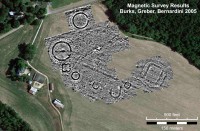 They had to pay through the nose with money they don’t actually have in hand quite yet, but the non-profit Arc of Appalachia, in collaboration with four other heritage and environmental organizations and donors like you and me, was able to purchase 193 acres of the Stark farm at auction on Tuesday, saving the ancient Hopewell earthworks known as the Junction Group. It’s an amazing result, especially when you consider that they only found out about the sale two weeks ago and the fundraising began eight days ago. They had to go up against some monied interests as well, housing developers who could have seriously damaged if not obliterated this sacred Native American ceremonial site.
They had to pay through the nose with money they don’t actually have in hand quite yet, but the non-profit Arc of Appalachia, in collaboration with four other heritage and environmental organizations and donors like you and me, was able to purchase 193 acres of the Stark farm at auction on Tuesday, saving the ancient Hopewell earthworks known as the Junction Group. It’s an amazing result, especially when you consider that they only found out about the sale two weeks ago and the fundraising began eight days ago. They had to go up against some monied interests as well, housing developers who could have seriously damaged if not obliterated this sacred Native American ceremonial site.
Arc of Appalachia was ambitiously hoping to buy the entire 335-acre farm even though the earthworks just take up about 25 acres of one 89-acre plot because they wanted to combine protected cultural heritage with a nature preserve. The farm was divided into six lots. Besides the earthworks field, the coalition was able to acquire two forested tracks and a river corridor 1.2 miles long. These additional lots were key to preserving the full archaeological context of the site and to protect the delicate ecosystem of the woods and along the environmentally significant Paint Creek. The only lot they did not acquire was a large farm field of more than 170 acres. That was their lowest priority parcel and it sold to Dave Williams, a farmer who has worked for the Stark family for 22 years.
 Williams was bummed that most of the land went to the conservancy groups. “I’m in it for one reason, they’re in it for another. Sad part is, when they buy property, there’s no more revenue from it, tax from it, that’s the downfall.” I wouldn’t call it a downfall since land isn’t wasted just because it’s not being used to produce cash crops. Even if you do think of its value solely in monetary terms, this is far from the end of the land’s ability to generate revenue for the state and local business alike. The opposite is true, in fact. The ultimate aim here, let’s recall, is to turn over the site to the Hopewell Culture National Historical Park, and the national parks are a huge source of money from fees and the many associated expenditures park visitors (hotels, restaurants, souvenirs) make. I doubt farm taxes even come close to park revenues.
Williams was bummed that most of the land went to the conservancy groups. “I’m in it for one reason, they’re in it for another. Sad part is, when they buy property, there’s no more revenue from it, tax from it, that’s the downfall.” I wouldn’t call it a downfall since land isn’t wasted just because it’s not being used to produce cash crops. Even if you do think of its value solely in monetary terms, this is far from the end of the land’s ability to generate revenue for the state and local business alike. The opposite is true, in fact. The ultimate aim here, let’s recall, is to turn over the site to the Hopewell Culture National Historical Park, and the national parks are a huge source of money from fees and the many associated expenditures park visitors (hotels, restaurants, souvenirs) make. I doubt farm taxes even come close to park revenues.
With real estate developers gunning for their piece of the pie, Arc of Appalachia wound up spending more than a million dollars to save this precious historical and environmental resource, $650,000 for the 90-acre earthworks lot alone.
Here’s some number crunching for you. We bought 102 acres of forest, the earthworks, and a total of 192 acres of land for a total of roughly $1.1 million. Our average per/acre cost was $5751.
As you can see, we raised roughly $375,000 through the generosity of over 900 donors, funds which we will use to leverage a Clean Ohio grant to pay the remaining balance of acquisition funds needed. If you pledged your support or would like to contribute, please send your donation now.
Obviously they’re very confident that the grant will be forthcoming or else they wouldn’t have gone so high, but the figures look very daunting to me so there’s still plenty of room for donations. Now that the land is secured, you can contribute to the kitty without fear that it will be for naught. Click the donate button on this page to make good on your pledge or to help keep Arc of Appalachia in the optimism to which it has become accustomed. If you’d like to mail in your pledged amount (or more), please send it to Arc of Appalachia, 7660 Cave Road, Bainbridge, OH 45612.